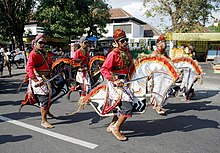Kuda Lumping

Kuda Lumping dance during a festival in Yogyakarta
|
|
| Genre | Traditional |
|---|---|
| Origin | Java, Indonesia |
Kuda Lumping (Javanese: Jaran Kepang or Jathilan, Malay: Kuda Kepang, English: Flat Horse) is a traditional Javanese dance depicting a group of horsemen. Dancers "ride" horses made from woven bamboo and decorated with colorful paints and cloth. Generally, the dance portrays troops riding horses, but another type of Kuda Lumping performance also incorporates trances and magic tricks. When the "possessed" dancer is performing the dance in trance conditions, he can display unusual abilities, such as eating glass and resistance to the effects of whipping or hot coals. Although the dance is native to Java, Indonesia, it also performed by Javanese communities in Suriname, Malaysia and Singapore.
The origin of Kuda Lumping is uncertain. Two main hypotheses have been proposed. The first suggests that Kuda Lumping may have arisen out of Diponegoro's war against the Dutch colonial forces, as a ritual reenactment of battles. The second argues that it is based on Mataram-era troops riding against the Dutch.
Kuda Lumping is known under different names in different areas. While Kuda Lumping is the most common name in West Java, in Central Java it is known as Jaran Kepang or Jathilan in East Java; in Bali, it is known as Sang Hyang Jaran. In Bali Sanghyang dance refer to the type of dance involving trance by spirit identified as hyang.
Kuda Lumping may be performed in celebration of a special event, such as a boy's circumcision or rite of passage. It may also be performed as entertainment, in a busker style. It is generally performed in a cordoned-off area, with the audience separated from the dancers.
...
Wikipedia
